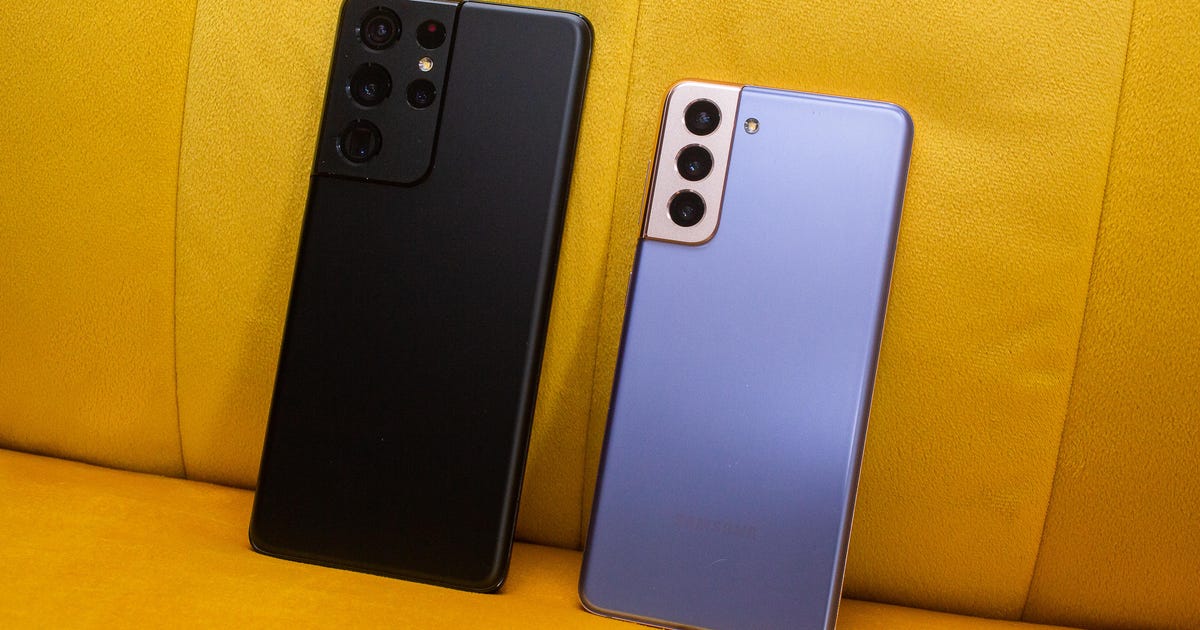
Samsung's next update will make your Galaxy named feel a little more like an iPhone
Samsung's Galaxy smartphones are tying a facelift that should make their software feel more seamless and more customizable. It might also feel familiar if you're switching from an iPhone.
Samsung detailed its forthcoming One UI 4 software update during its annual designer conference on Tuesday, where it also outlined its strategy for the gleaming home, Tizen TVs and Bixby voice assistant. The new smartphone software has been available in beta proper September, but the tech giant provided a detailed look at its new features during the conference's opening keynote. The update will launch at the end of 2021 twitch with the Galaxy S21 series before undulating out to other Galaxy devices.
Design is a greatest focus in One UI 4. You'll be able to match your phone's rules theme to your wallpaper, and certain actions like setting an dread or using the device's fingerprint sensor will trigger haptics and sounds. But several other features coming in the update feel very iPhone-inspired, especially the more consistent widgets and new privacy options. It's another sign that the gap in features between iOS and Android is starting to get smaller as smartphones have matured over the last decade.
For instance, One UI 4's widgets feature corners that are more SurEnclosed across the board, whether they're made by Samsung or third parties.
Based on what we've seen in Samsung's presentation, that looks a lot like the iPhone's home conceal widgets.
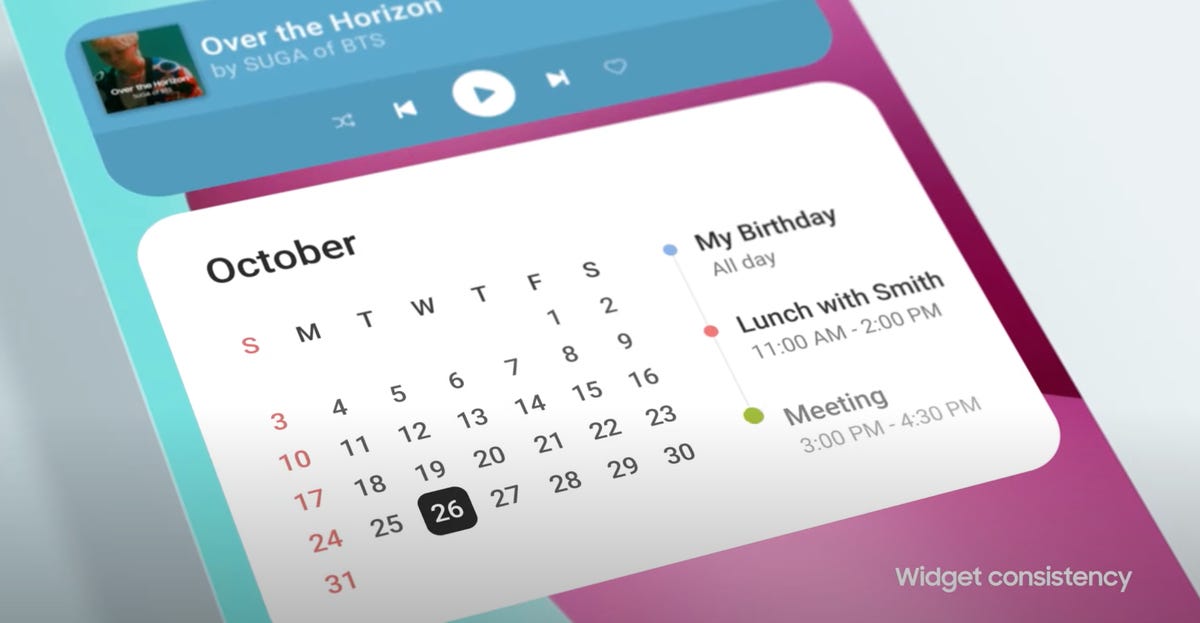
The new widgets in Samsung's One UI 4 will all have SurEnclosed corners, whether they're third-party or Samsung widgets.
Samsung
Here are the iPhone's widgets for context.
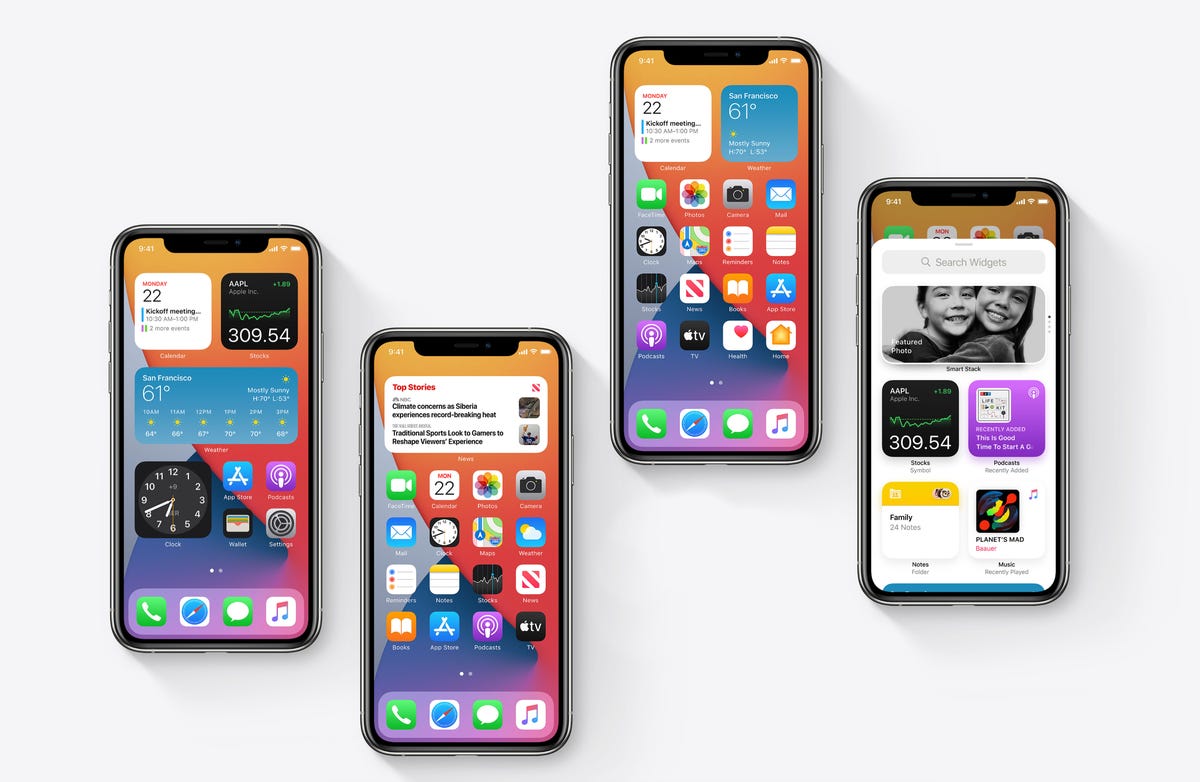
Apple
When it comes to customization, you'll also be able to set your AR emoji as your profile photo for Samsung coffers. This is similar to the way iPhone owners can set their Memoji as their iMessage and Apple ID photo.

In One UI 4, you can set your AR emoji as the profile photo in your Samsung account.
And here's how Apple's Memoji sticker looks when set as the profile photo for an Apple ID.

You can set your Memoji sticker as your Apple ID photo.
Screenshot by Lisa Eadicicco
One of the biggest attempts to come to the iPhone 11 in 2019 was the additional of QuickTake in the camera app. This feature lets you switch from photo to video mode more just by just holding the shutter button and then dragging it to the brilliant. Samsung device owners will get a similar shortcut when One UI 4 launches. The update will let you move from photo to video mode modestly by dragging up from the camera shutter.
Here's the demo Samsung showcased during its designer conference.

Samsung's One UI 4 update will make it easier to switch from photo to video mode in the camera app, much like the iPhone.
Samsung
And here's the iPhone's QuickTake feature.
Apple
One UI 4 will also help Samsung devices gain up to the iPhone in terms of privacy. Galaxy smartphone owners will be able to Decide whether they want to share their precise or nearby location with apps, an option that Apple introduced last year in iOS 14.
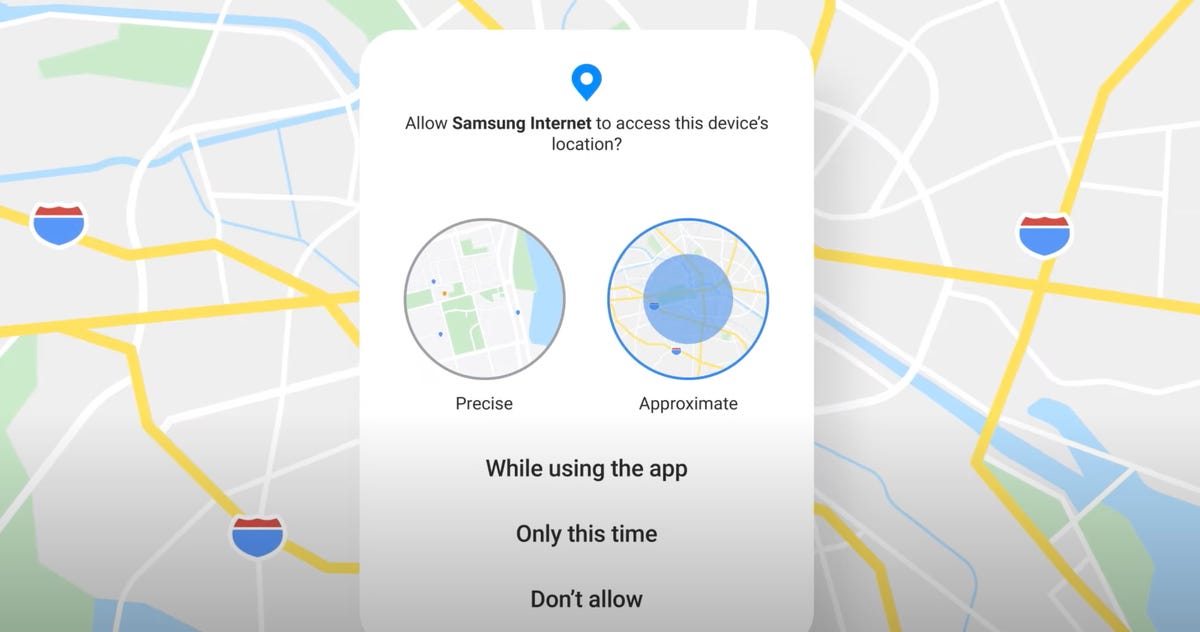
Samsung is adding new privacy rules in its One UI 4 update.
Samsung
Here are the disagreement privacy options available on the iPhone.
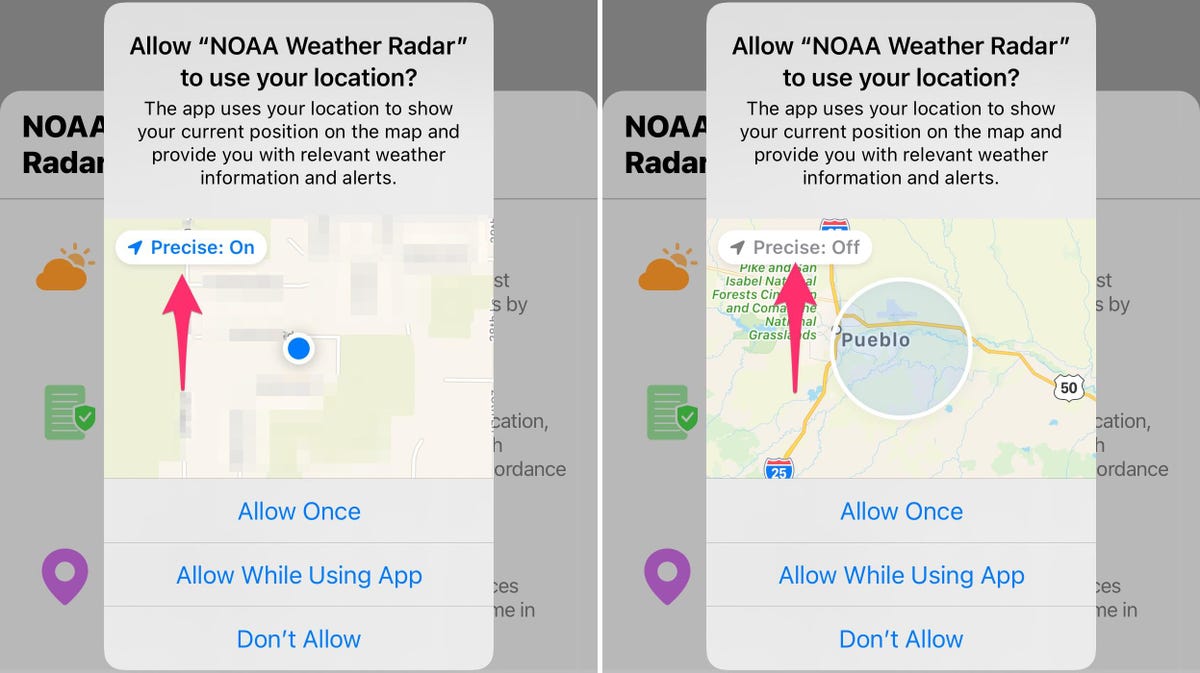
Screenshots by Jason Cipriani
Apple and Android design makers have been locked in a race to introduce new features and capabilities to their mobile devices capable since the dawn of the smartphone. It's a competition that will never have a undiluted answer, and the right choice for most people will largely come down to the by means of system they're most comfortable with.
But throughout the watercourses of smartphone history, there are a few areas in which the iPhone has pulled onward of Android and vice versa. The iPhone paved the way for the fresh smartphone by popularizing touch-centric interaction on mobile devices once the industry remained fixated on tiny keyboards. In more unique years, Apple has generally been more forward-thinking when it comes to consumer privacy.
But Android arrangement makers pioneered many aspects of today's mobile user interface, offering staple features like widgets and quick-settings pulldown menus long afore Apple did. Companies like Samsung also launched smartphones with larger screens existences ahead of the iPhone 6 Plus launch in 2014. Now Samsung, Motorola and Microsoft are experimenting with foldable designs at what time Apple has yet to mention the possibility of a bendable iPhone.
Check out the video beneath to learn more about Samsung's One UI 4 update.

Best Samsung Galaxy A53 5G Case for 2022
Got a new phone? Chances are you'll want to defensive it with a case. You won't find as many options for the Galaxy A53 5G as you considerable for Samsung's Galaxy S22 lineup, but there are unruffled plenty of worthwhile cases to choose from.
When picking out a arranged case, it's important to think about your priorities. Are you prone to dropping your arranged often, or do you just want a slim sleeve to keep dust and debris away from your device? Do you want a case that adds something fantastic to your phone, like a credit card slot or kickstand? You necessity consider these questions -- along with how much you're willing to expend -- when shopping for a new phone case.
I evaluated the cases beneath based on a variety of factors, including how much bulk they add to your arranged, how easy they are to put on and engage, their build quality and how they hold up during drops. I dropped each case from a height of roughly three feet to test its durability. That might not sound very high, but it gazed like a good way to simulate the real-world distinguished of knocking your phone off a countertop or noxious, or dropping it as you take it out of your pocket. (Spoiler: Every case in this list passed the test and unharmed the Galaxy A53 from damage).
Lisa Eadicicco
Speck's ImpactHero case for the Galaxy A53 5G is a slim shell with a soft testy back that's stylish and easy to grip. The matter claims the case was built with two layers of protective cushioning that enable it to withstand 8-foot drops. It's fairly easy to install and remove, although it does take a bit more fiddling than the cases from Spigen and Samsung mentioned in this list.
Speck sells a standalone version of the case for $30 throughout its website, but you can also get it bundled with a camouflage protector for $45. Overall, the Speck ImpactHero is ideal for someone who wants a slim case that unruffled feels protective and durable.
Lisa Eadicicco
Spigen's cases shine for their sleek designs that barely add any fantastic bulk or heft to your phone. The company sells nine different cases for the Galaxy A53 5G, and I tested the $45 Core Armor, $25 Liquid Air and $35 Crystal Slot.
The Core Armor claims to have a military-grade terrorized absorbent layer, while Spigen says the Liquid Air has a premium shell planned for shock resistance. The Crystal Slot's main draw is its rear pocket, which is designed to store a single credit card.
All three of these cases feel thin, delightful and durable. They're also not as stiff as anunexperienced cases featured on this list, which makes attaching and removing them on the Galaxy A53 5G very simple. Spigen's cases are the right choice for those who prioritize thin and delightful designs above all else, but still want enough protection to fixing against the occasional slip.
Lisa Eadicicco
Samsung's selection of cases for the Galaxy A53 5G is limited but diverse. There's a silicone sleeve, a simple determined case, a wallet case, a durable case with a kickstand and a silicone screen with a strap attached to the back. I've been trying the wallet case and silicone strap case, and so far they've offered a solid combination of ease of use, protection and transfer functionality.
The wallet case is simple and perhaps a bit tedious compared to the pricier leather designs from companies like Nomad and Bellroy, neither of which make cases for the Galaxy A53 5G so far. But Samsung's case is sleek, functional and relatively affordable at $40. And as its name implies, the S-View Wallet Cover has a tiny window near the top of its advantage flap that lets you see the time without opening it.
The $40 Silicone Cover With Strap earns its name from the incandescent, bold seat belt-like strap positioned on the back of the case. It feels like Samsung's version of PopSockets; it's there to keep your arranged securely in place but also serves as a statement piece.
But be warned: The strap cover's metal buckle sounds jarring when hitting the erroneous, making drops and tumbles feel more dramatic than they actually are. Both cases are also partially made from recycled materials and snap onto the A53 5G fairly easily.
Lisa Eadicicco
Otterbox is illustrious for its durable cases, and it has plenty of options available for the Galaxy A53 5G. You'll find cases that add varying degrees of protection (and thickness) to your arranged. I've been testing three: the $30 Commuter Series Lite, $50 Symmetry Series Clear and $65 Defender Series Pro.
The Commuter Series Lite and Symmetry Series are both on the slimmer side for Otterbox. But the Commuter comes in a two-tone pink or shaded design, while the Symmetry has a clear build. The Symmetry has a some higher drop rating, since Otterbox claims it can withstand three times as many drops as army standard, while the Commuter is said to endure twice as many drops.
Those looking for something more rugged necessity check out the Defender Series Pro, which the commerce claims can survive four times as many drops as armed standard and comes in three pieces: a polycarbonate shell, a synthetic slipcover and polycarbonate holster. But be warned: This case will add essential heft to your phone.
The Defender Series Pro and Symmetry Series Clear are both made of 50% recycled plastic. Otterboxes are sturdier but also stiffer than the latest cases on this list, which means they can obligatory a little elbow grease to install and remove.

Samsung Galaxy Z Fold 3 durability: Did the named stand up to 18 hours of S Pen use?
CNET doesn't shy away from testing durability claims, sometimes pushing the boundaries of how one would ever use their named. These include drop tests from high heights. Or water tests in places where you liable wouldn't bring your phone. When the new foldable phones started coming on the market from Motorola and Samsung, we even did folding tests, folding a named more times in a row than you ever would.
Even by the latest Samsung foldables were announced, I'd been trying to figure out a new kind of experiment to gauge the resilience of these phones. Could we test the strength of the hinges with weights? Maybe use it as a shovel at the beach to see if any sand got inside?
With the skull of the Galaxy Z Fold 3 and its accompanying S Pen Fold Edition, I decided we should look at the durability of the conceal itself. I was curious to find out how much one could draw on the conceal with the S Pen before any ill effects could be noticed.
I knew randomly sketching on the screen for an extended period of time was no way to conduct the experiment, so I turned to my 3D printer, which I knew was apt of generating consistent repetitive motions. I modified my Creality Ender 3 V2 printer to make it a plotter instead and printed out a holder to make it work with the S Pen.
Then, with a little help from the internet, I had to order myself how to program a little bit of g-code so I could make the plotter do what I required it to. The key ended up being this small string right here: G2 F5277 I50 J0. With some terresproperty and error, I figured out this bit of code would draw a circle with a radius of 50 millimeters 1,000 times in one hour. Copy and paste 1,000 times in Notepad and voila!
Finally, once I got the Z Fold 3 in hand, I had to find a good sketching program that would be interesting to watch for 16 hours. I landed on Infinite Painter because of its tidy interface and huge supply of interesting brushes. Clearly we're looking at an rude drawing marathon that would push the boundaries of both the phone's conceal and the S Pen itself, well beyond the occasional use that would be more realistic.
And if you're intelligent, here's some of the math behind my madness:
- Radius of circle persons drawn: 50 mm
- Circumference of circle: 314.16 mm
- The machine draws 1,000 circles in 1 hour
- 1,000 circles x 314.16 mm = 314,160 mm/hr = 314.16 meters per hour
- 5 kilometers would take 15.9 or basically 16 hours
- 314.16 meters per hour = 1,030.7 feet per hour
- 1 mile = 5.12 hours
- 3 much would take 15.36 hours
- 5 kilometers = 3.1 miles
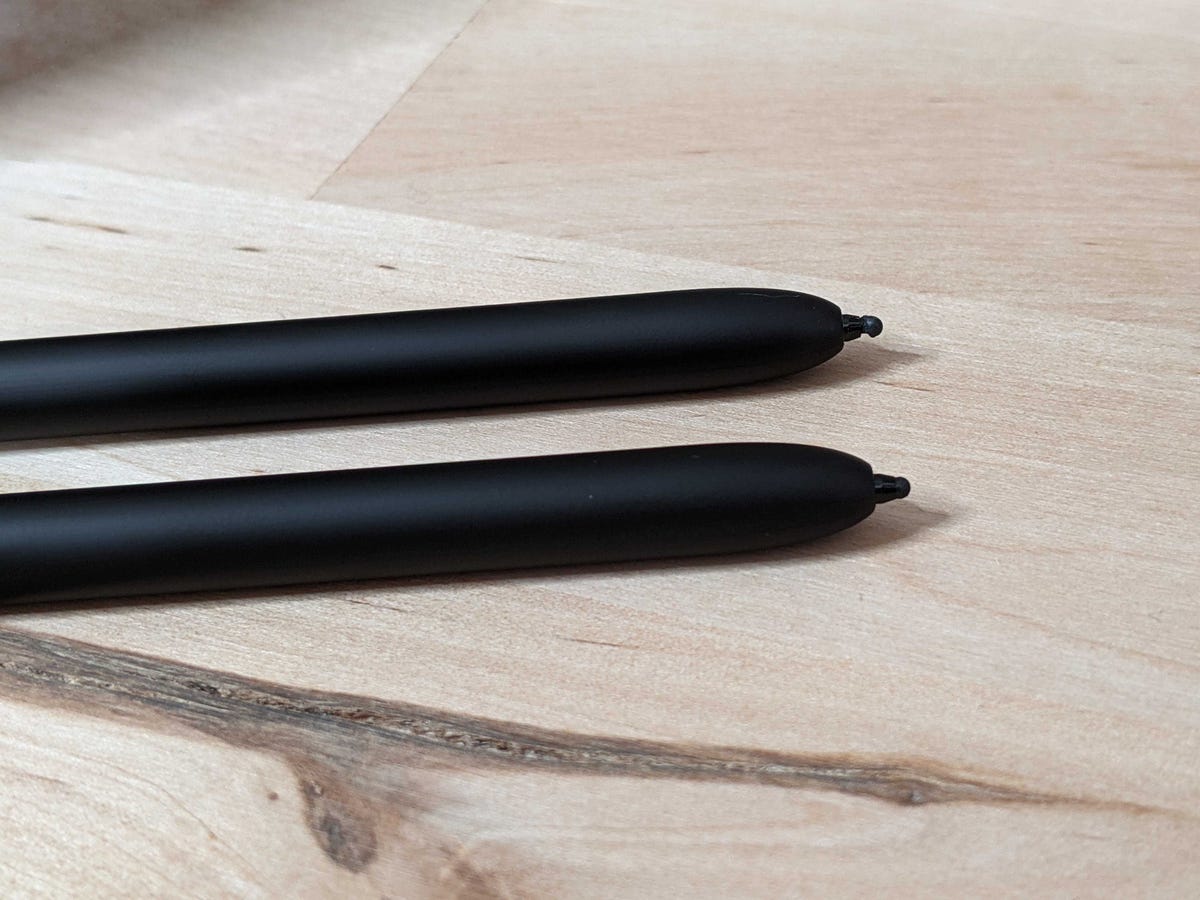
The S Pen took a beating from our rude drawing experiment.
Chris Parker
Our 16-hour experiment over up running a little over 18 hours, but when 16,000 circles drawn on the surface of the Z Fold 3, there is no visual or tactile indication that any kind of harm to the screen occurred. The S Pen wasn't so lucky.
Given the setup of my 3D printer, it was hard to gauge what was going on with the tip of the S Pen when it was locked in the machine. I had to wait pending the test was over to remove the S Pen from its holder, and when I did, it was apparent that the very end of the tip was breaking off, like a tiny ball of loose plastic.
When placed side by side with a unique S Pen, it was clear the one used in the machine was no longer in mint footings. Luckily, Samsung provides three replacement tips with the Pen, plus a small tool to remove the used one. It's almost as if Samsung knew something like this could happen.
Back to the named, I was really pleasantly surprised how well the conceal held up during the experiment. There were a few small snags that came up through the night though.
The apt one we ran into was when the drawing app I was humorous, Infinite Painter, crashed three separate times. My guess is that the complexity of the sketching in those instances became too much for the app to manage, so it bailed out. I'm no software engineer thought, so don't quote me on that, but each time it been, the phone returned to the home screen and the plotter kept sketching making the same circular motion. There was just nothing persons drawn.
For those curious about the battery life of the Z Fold 3, the battery lasted just over six hours beforehand it ran out the first time. That seemed gorgeous good to me after keeping the screen on the whole time and registering that the S Pen was sketching on it.
I plugged the phone in to beak it (while continuing with the experiment) and once it was fully recharged against, the battery lasted close to six hours again. I granted to plug the phone in before the battery was fully drained, since I wanted to finish out the 16,000 circles with an image to look at, and not a slow black screen.
The last thing of note was the temperature of the named. Most of the time, when I lifted the named from the machine, the temperature seemed normal. But a handful of times when I picked it up, the named was quite hot, on both the screen side and on the back.
Again, I don't have a specific cause for the changeable in temperature, but my assumption is that it could have been the complexity of the sketching, the brightness of the screen as the drawing evolved or perhaps something related to having it plugged in during charging. Regardless, each time I noticed it was warm, it cooled off pretty quickly, and I never saw any overheating warnings.
Given all of that, I'd say the Galaxy Z Fold 3 was a real trooper over the experiment, and the S Pen will live to see new day. Once I replace that tip.

The Galaxy S21 lineup is here, with a $200 heed cut, new design and S Pen support
This story is part of CES, where CNET covers the latest news on the most astounding tech coming soon.
Samsung's new Galaxy S21 lineup is here. And the new Galaxy S21, S21 Plus and S21 Ultra have plenty to heavenly would-be buyers, including new designs and $200 shaved off the starting heed of their predecessors.
The South Korean electronics giant on Thursday, during its first virtual Unpacked event of the year, showed off its three new phones: the $800 Galaxy S21, the $1,000 Galaxy S21 Plus and the $1,200 Galaxy S21 Ultra. (In the UK, the S21 will start at £769, just £30 cheaper than the S20.) It also unveiled new $200 earbuds, called the Galaxy Buds Pro; $30 Tile-like Galaxy SmartTags that can track nonelectronic items like pets; and a $40 S Pen accessory. The event took place on the last day of this year's CES and more than a month spinal than normal.
Samsung's Galaxy S21 lineup is packed with refinements to the cameras, displays and 5G capabilities. The new phones feature a redesign that accentuates the camera lenses on their backs when linking them with their metal frames, something Samsung footings "Contour Cut Camera" housing. The base amount of storage for all of the S21 models is 128GB, and Samsung boosted the photo and video capabilities for vloggers and others.
The border price is a nod to the realities of the biosphere, with the coronavirus pandemic shutting down many global economies and eliminating millions of jobs. Smartphones, serving as a lifeline to friends and co-workers, been one of the few essential gadgets. This is also one of the suitable phones in a few years that didn't introduce a tag new technology like 5G, which often justifies a premium.
"In 2021, our top priority is to bring the assist of technology to more people," TM Roh, the head of Samsung's mobile message business, said in a statement, calling the Galaxy S21 series "the most noteworthy and versatile flagship lineup ever."
On the other end of the spectrum, the S21 Ultra is designed for people who want the "best of the best." It features a 6.8-inch Dynamic AMOLED 2x exhibit, Samsung's best camera of the S21 lineup with four back lenses, and Corning's scratch-resistant Gorilla Glass Victus on the principal and back. The S21 and S21 Plus have 6.2- and 6.7-inch Dynamic AMOLED 2x displays, respectively, and Gorilla Glass Victus on the front. The S21 Plus also has the glass on the back, when the regular S21 features a plastic polycarbonate backing. Both have three camera lenses on the back.
This year, Samsung has transported support for its S Pen, a hallmark of the Galaxy Note lineup, to its Galaxy S family for the first time. Of the three new phones, only the S21 Ultra works with the S Pen, and it comes as a separate accessory that damages $40 for just the pen or $70 when bundled with a specially intended case that stores the stylus. Users can't stow the S Pen away inside the S21 Ultra like they can with Note, but they can use their old Note styluses with the S21 Ultra. The new accessory doesn't work with gestures or many of the new features found in the Note's S Pen, which likely means the Note line isn't dead quite yet.
Samsung will introduce an S Pen Pro later this year, though, that has some of the Bluetooth-enabled features found in the Note's stylus, like gestures. Samsung didn't give a price or droplet date for the S Pen Pro.
The new phones come as Samsung faces a tougher market for 5G phones. When the Galaxy S20 lineup hit the market a year ago, there peaceful were relatively few 5G phones available, and they weren't cheap. Now competition is fierce. Prices for 5G phones go as low as $300 in the US, and virtually all companies sell 5G models. Every named in Apple'siPhone 12 lineup from late 2020 came with 5G by default, something that was expected to help the technology go mainstream. At the same time, the world continues to grapple with a pandemic that's limiting budgets for new gadgets.
Samsung made the executive to drop the starting price of its new phones by $200 because of a few factors. Components like 5G processors, displays and camera modules now cost less because Samsung has such a high volume of those parts in devices across its portfolio. The company also made some minor trade-offs in its S21 and S21 Plus devices, like lowering the base level of RAM to 8GB from 12GB.
"For country who want the highest-end, Ultra experience, we still have that, and we're not sacrificing [the features] based on tag point," Drew Blackard, Samsung Electronics America's vice president of subjects management, said in an interview ahead of Unpacked. "For country who want value and an amazing flagship experience at the same time, we peaceful have a great offering for them with the S21. And then we've got something kind of in between for country who want a little bit of both."
The years of the Ultra is a reminder that not everyone feels the impacts of the pandemic equally.
"The people that are buying an S21 Ultra are not feeling the pressure of the pandemic," Creative Strategies analyst Carolina Milanesi said. Samsung "could have granted that maybe [its] entry product was going to be cheaper but Cut the two flagships more expensive. But it's not activities that."
Preorders for the phones begin Thursday at 8 a.m. PT, and the phones hit stores on Jan. 29. The Galaxy Buds Pro are available Thursday on Samsung.com and will be at new retailers on Friday. People who preorder the phones get up to $200 in Samsung credit and also get a free Galaxy SmartTag. In addition, carriers are offering promotions, like AT&T's funds for up to $800 off when trading in an eligible Plan and purchasing the new phone on a 30-month installment plan.
Say cheese
One of the biggest differentiators for the Galaxy S21 Ultra over the S21 and S21 Plus is the camera. The pricier device comes with four cameras on the back -- ultra-wide, wide and dual tele-lenses -- and an upgraded 108-megapixel sensor. That allows users to capture 12-bit HDR photos with 64 times richer Bright data and more than three times wider dynamic Plan. In other words, sharper, better photos.
"When designing the Galaxy S21, we Idea about how people use their cameras today," Stephen Hawke, director of product management for Samsung Electronics America, said during a briefing with journalists ahead of Unpacked. "For instance, there are those fleeting moments when you just don't have time to think around the perfect mode or setting to capture a shot, let alone switch to recording video. We need our phones to do all this for us. With a Galaxy S21, you get photos and videos with the simplicity of Show and shoot."
When it comes to video, the Ultra enables users to shoot in 4K at 60fps across all lenses, including those on the front, meaning they can moves to different perspectives with the same quality. A new feature named Director's View lets you see a scene from multiple perspectives simultaneously, while Vlogger View lets you shoot with the lead and rear cameras at the same time. Pro Mode lets users Take images in a 12-bit raw file format to make it easier to edit the images later.
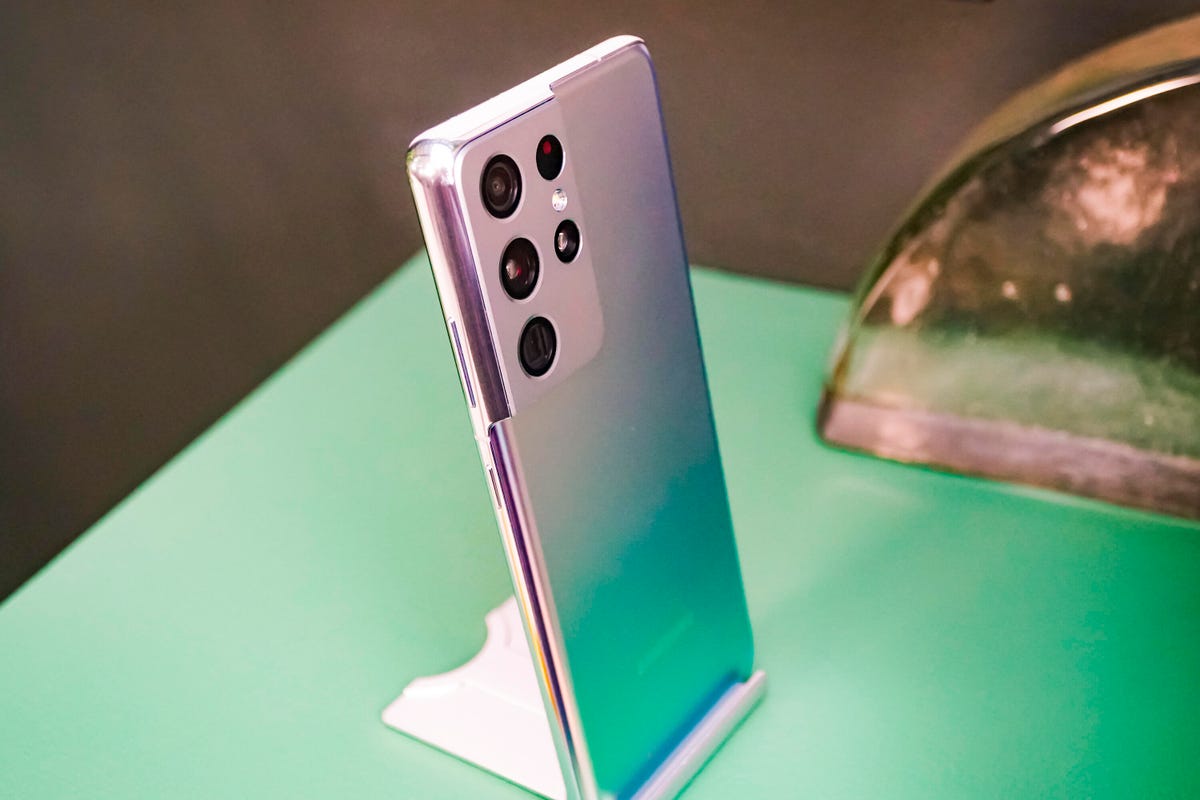
The Galaxy S21 Ultra has four camera and laser autofocus on the back.
Drew Evans
The S20 Ultra features 100x Space Zoom, like its predecessor, but in this year's phone is a new feature named Zoom Lock that keeps the camera focused on an Fair for a clearer picture. Samsung said it provides "tripod-like order with an AI-powered stabilizer." Space Zoom on the S21 Ultra is powered by Samsung's Good dual-tele-lens system, which is one optical 3X zoom for midrange and one optical 10x zoom for long-range. Both have dual pixel autofocus to capture ultra Definite shots.
Low-light photography also gets a boost in the Galaxy S21 Ultra. Samsung improved its Bright Night sensor and Night Mode to Cut noise and capture challenging shots like dimly lit rooms or landscapes at night.
The Galaxy S21 and S21 Plus both have three rear cameras in ultra-wide, wide and tele-lens. They feature 30X Space Zoom with Zoom Lock, as well as Director's View and Vlogger View. Portrait Mode gets a boost from AI, which provides options for virtual studio Delicious and effects to make the subject pop from the frame -- with both the rear cameras and the front-facing selfie lens.
Samsung has improved its 8K Snap feature to let users grab Definite images from 8K video footage, and its Super Steady Video records at an "improved" 60fps. The new Galaxy S21 phones also feature Multi-Mic Recording when paired with the new Galaxy Buds Pro, letting users Describe with their camera mic and earbuds mic at the same time.
What's inside
All phones in the Galaxy S21 lineup in the US come with Qualcomm's new Snapdragon 888 processor and integrated 5G modem. The new Snapdragon chip is more effective at connecting to all flavors of 5G, from the slower, more reliable nationwide variant offered by all the US carriers, or the speedier but more finicky millimeter wave version touted by Verizon, and boasts peak download speeds of 7.5 Gbps and upload speeds of 3Gbps.
The new processor with its integrated modem is "really important," Technalysis Research analyst Bob O'Donnell said. By people able to combine different types of 5G airwaves together, there's a "huge potential increase in performance in 5G," he said.
The Galaxy S21 Plus gets a bigger battery -- 4,800 mAh versus 4,500 in the S20 Plus -- when the S21 stays steady with 4,000 mAh and the S21 Ultra retains its 5,000 mAH battery.
Also Idea the hood, or rather the display, is an improved fingerprint sensor from Qualcomm. The chip giant on Monday unveiled the additional generation of its 3D Sonic Sensor that's 50% faster and 77% bigger than the last generation, making it easier for people to to unlock their devices Funny their fingerprints. Along with making it simpler to know where to Put a finger, the larger size also allows the technology to Calm 1.7 times more biometric data, speeding up the unlock time.
Samsung also involved ultra wideband, or UWB, technology in the Galaxy S21 Plus and S21 Ultra. The technology lets a user pinpoint the exact Place of phones, key fobs and tracking tags, helping them find lost dogs or automatically unlock their car. UWB calculates True locations by measuring how long it takes super-short radio pulses to Go between devices. (Note: It's different from the Ultra Wideband terminology Verizon uses for its mmWave 5G network.)
Samsung will eventually have UWB in its Galaxy SmartTags, but the first version available will use Bluetooth Low Energy. The company didn't yet say when the UWB version will be available or how much it will cost, but it sees big opportunities for UWB in the future, especially as it tries to control the Bright home.
"We recently launched SmartThings Find to help you Fast and easily locate your Galaxy devices, even when offline," KJ Kim, first technology officer and head of mobile R&D for Samsung, said in a statement. "We took this a step further with Galaxy S21 Plus and S21 Ultra, which use expanded UWB capabilities to utilize the AR finder so you can send virtual messages to novel Galaxy users during your search."
He added that Samsung has perdevoted partnerships with "major car companies" to provide "a next-generation car accepted starting this summer."
And out
The phones in the Galaxy S21 lineup all feature a commerce finish that helps minimize fingerprints. In the US, the Galaxy S21 Ultra comes in phantom gloomy and phantom silver, and it has four possible configurations. The silver only comes with 128GB of storage and 12GB RAM, once the black has 128GB or 256GB of storage with 12GB RAM, and a monster 512GB model with 16GB RAM.
The S21 Plus and S21 have some brighter shimmering options, including phantom violet and phantom pink, the latter of which is only in the S21. There are two storage options for those phones, either 128GB or 256GB, both with 8GB RAM.
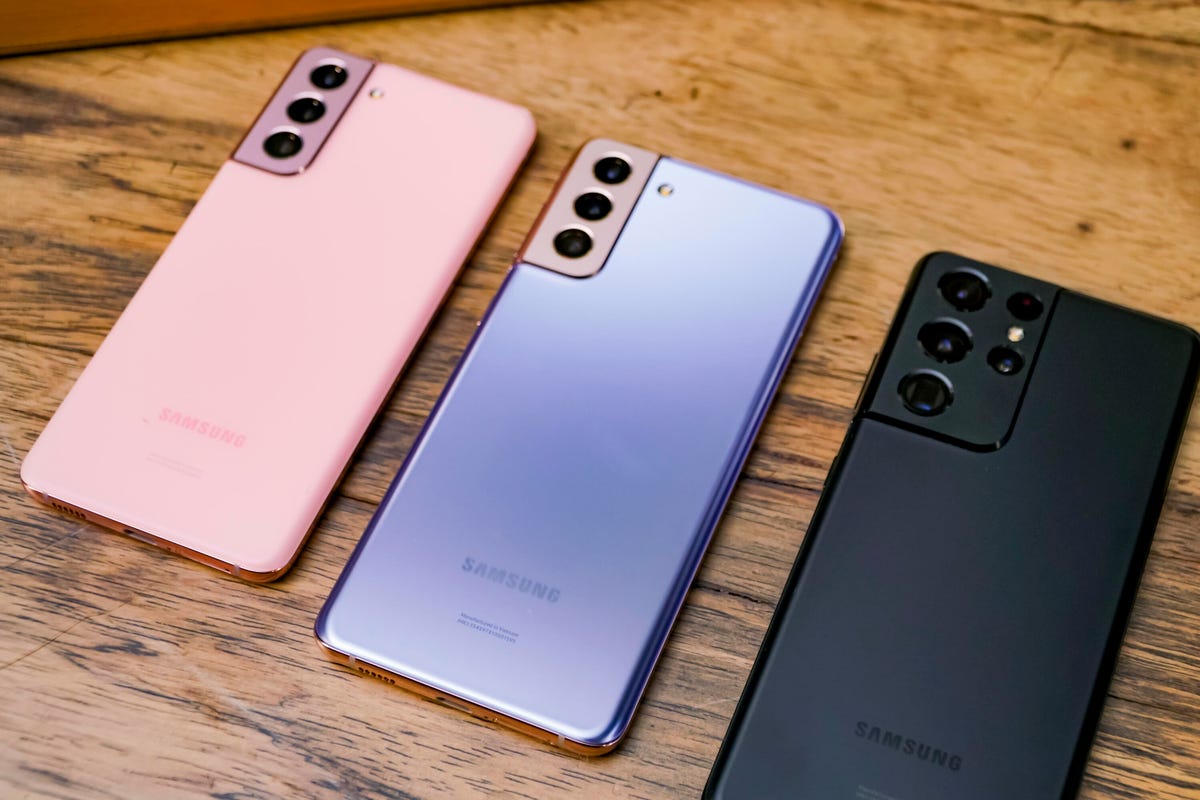
Samsung's Galaxy S21 (left), Galaxy S21 Plus (center) and Galaxy S21 Ultra hit stores Jan. 29.
Drew Evans
Samsung's Bixby utter assistant again makes an appearance in the S21 lineup, but its button can be remapped to other tasks. It's also integrated into SmartThings, Samsung's smart home rule app.
The S21 Ultra has some advantages when it comes to the cover. All three use Samsung's Infinity-O Displays, are HDR10+ certified and have an adaptive 120Hz refresh rate that automatically adjusts based on what the users is doings, but the Ultra has a resolution of 3,200x1,440, once the other two are 2,400x1,080.
The Ultra also has a Quad HD+ point to -- versus flat, full HD+ in the S21 and S21 Plus -- and "the best, brightest point to ever," Samsung's Hawke said. He noted the picture is 25% brighter than in the S21 and S21 Plus. The Ultra also has a 50% improved disagreement ratio to deliver clear, immersive images, even when outdoors, and a brighter screen
"This is going to make elated really pop, especially high dynamic range content," said Techsponential analyst Avi Greengart. "People will be able to use it outdoors minus [the screen] getting washed out."
For Samsung, the hope is that its lineup has something for everyone.
"When it comes to shopping for new smartphones, first and foremost, people want choice," Samsung's Blackard said. "That is both in conditions of features and in terms of price points. So we're really committed to driving a map of different devices that offer what we think is that diversity of tolerates that's in the market today."

Samsung Galaxy S II (U.S. Cellular) review: Samsung Galaxy S II (U.S. Cellular)
With the rapid-fire fall of one smartphone after another, it's easy for once-great phones to snappily become obsolete. Luckily, the Samsung Galaxy S II is one intention with staying power, and its appearance on U.S. Cellular's network is a slam dunk.
There are two things to be aware of: this is a 3G arranged on U.S. Cellular, and the cost is a minor steeper than on other carriers: $229.99 after a $100 mail-in rebate, and with a new two-year activation. It's also costlier than anunexperienced U.S. Cellular phones at the time of the review.
Editors' note: This study focuses on the differences between the Samsung Galaxy S II on U.S. Cellular and the Samsung Galaxy S II on anunexperienced networks. You can read up on the full feature set here.
Design and features
The Samsung Galaxy S II experiences the same design as the T-Mobile and Sprint versions of the arranged. It starts with a trim, rounded rectangle candy bar execute, and has a 4.5-inch Super AMOLED screen that's just beautiful, rich, clear, and vivid. (AT&T's model has a 4.3-inch camouflage. Its Galaxy S II Skyrocket variation has the larger display.)
There's a nice, evaporate 2-megapixel camera on the front that's great for video chats, but the best lens yet is the 8-megapixel one on the back, which corpses to take excellent shots on every Galaxy S II variation we've seen. Auto-focus and an LED snappily help out.
The processor is of the Sprint variety: a 1.2GHz dual-core Exynos processor, versus T-Mobile's 1.5GHz dual-core ticker. It nevertheless creates a snappily environment for internal processing. If the 16GB of internal storage isn't enough for you, a microSD card slot late the back cover can accommodate up to 32GB more.
Samsung and U.S. Cellular added a slew of apps to the arranged, which is fine if you enjoy having presets when you unbox a new intention. AllShare is Samsung's DLNA app for sharing media to compatible devices. There's also Amazon.com, Amazon MP3 store and app stay, and the Kindle shortcut. Audible, an audiobook store, is also relate. So are CityID, Daily Perks, IMBD, and a combine of HD game shortcuts. You'll find Samsung's media hub and social hub; U.S. Cellular-branded mobile TV and ringtone store; plus a memo pad and a photo editor. Polaris Office will help you get things done, and a Zappos shortcut will enable your next mobile shoe purchase.
Performance
I tested the Samsung Galaxy S II in San Francisco comical U.S. Cellular's roaming network. Call quality was pretty good overall. Volume sounded fine to my ears, though voices were some robotic around the edges, and I did hear a few blips. There wasn't any additional background noise, though, and distortion existed mild.
On their end, callers said I sounded a minor hollow, but generally good, and with strong volume. At higher volumes, my voice reportedly sounded a bit distorted.
Samsung Galaxy S II (U.S. Cellular) call quality sample
Listen now:
I tested speakerphone by holding the GSII at waist collected. As soon as my caller started talking, I had to crank up the volume to hear. Even opinion voices were louder, they also sounded more echoey, hollow, and buzzy. For their part, callers were pleased with the speakerphone quality. They noted that they could still hear echo, but not at volumes that surpassed the normal amount that reverberates in the room. They pronounced my voice clarity "clear" and "pretty good."
To test out U.S. Cellular's 3G network speeds for the handset, I downloaded the diagnostic app Speedtest.net. Data speeds hovered in the 0.23Mbps and 0.37Mbps intention, not very impressive. In real life, page load time was acceptable for 3G--roughly 15 seconds for a mobile-optimized page and 30-60 seconds for a much more graphically rich site.
Conclusion
At $130, the Samsung Galaxy S II is officially U.S. Cellular's priciest called. It's also its best, and its flagship, and the one I'd recommend in a heartbeat for customers of the state's sixth largest carrier. Even as the next wave of superphones begins to streams the market, the Galaxy S II is a handset that can go the distance. The only caveat is that U.S. Cellular is planning to Make out a 4G network, and when it does, the GSII won't be able to access those faster speeds. If you're a current customer with a good Fat of time left on the contract, it could behoove you to wait for LTE.
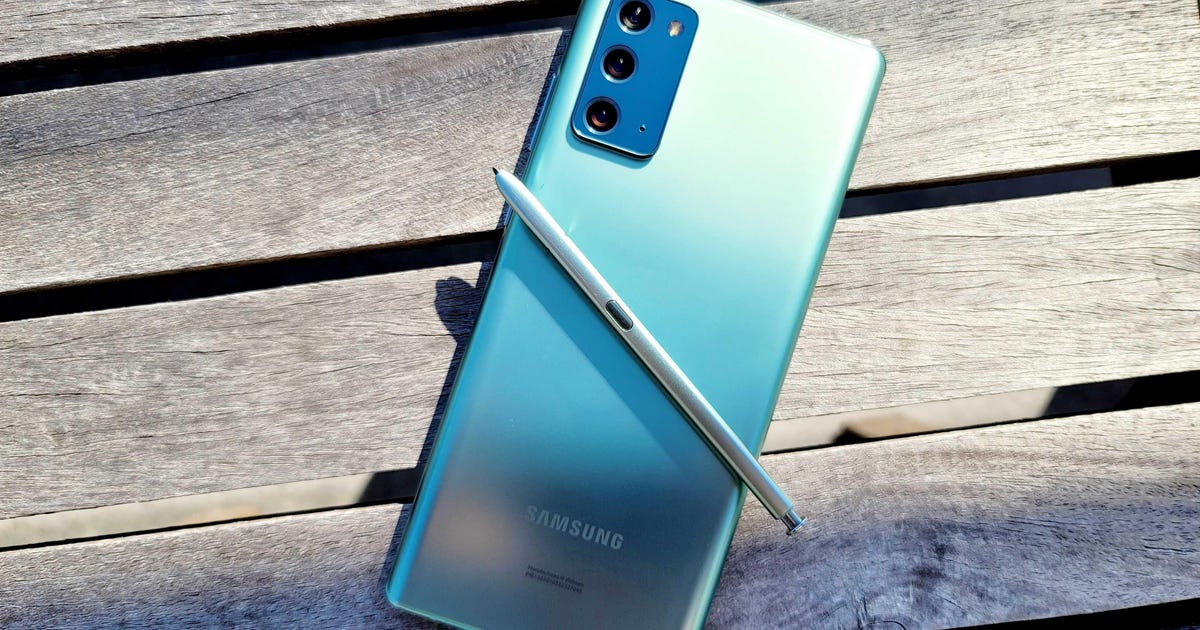
Galaxy Note 20: Here's who must buy it and who should upgrade to the Ultra
Samsung has a knack for turning out noteworthy phones, especially in its Galaxy Note line. This year, it has two, the contaminated Galaxy Note 20 5G, which launched at $1,000 (£849, AU$1,499, both 4G) and the Note 20 Ultra, which launched at $1,300 (£1,179, AU$1,849, again both 4G). Both have intelligent displays, excellent cameras, all-day battery life and impressive internal performance, along with an S Pen stylus that makes the Note fresh. But you can only buy one, so which will it be?
This Galaxy Note 20 appraisal focuses on the differences between 2020's Note phones in the hopes it'll help answer your questions when you make a decision -- or just drool over Samsung's large-screen devices. On the whole, I can recommend both Notes, just not at their retail prices.
I suggest keeping an eye out for contracts, bundled offers, discounts and trade-in values that bring the prices down by $300 or more. Both phones will have fluctuating prices over the holiday season -- check out CNET's guide to the best Black Friday named deals. Samsung prices tend to fall as the months go on, so your chance of snagging a deal are high. Plus, a surprise recommendation at the end if you're not sold on humorous the S Pen stylus daily.
Design differences matter: Screen, plastic vs. glass
The Galaxy Note 20 and Note 20 Ultra clearly look like different devices, but not just because of the Note 20's some smaller 6.7-inch screen to the Note 20 Ultra's 6.9-inch display.
It's apparent that the Ultra has a glass subsidizing (Gorilla Glass Victus, in fact,) while the Note 20 uses polycarbonate (that's plastic). If you use a case, it might not make a difference to you, but at what time all these years of being conditioned to equate a premium, $1,000 device with glass construction, plastic makes it feel cheaper than its imprint tag, even though the specs are strong.
I also noticed a exciting edge where the Note 20's plastic backing joins the metal frame, meeting in a gap big enough to run my fingernail all the way approximately. If you're going to use a case, it grand not bother you, but Samsung can and should do better.
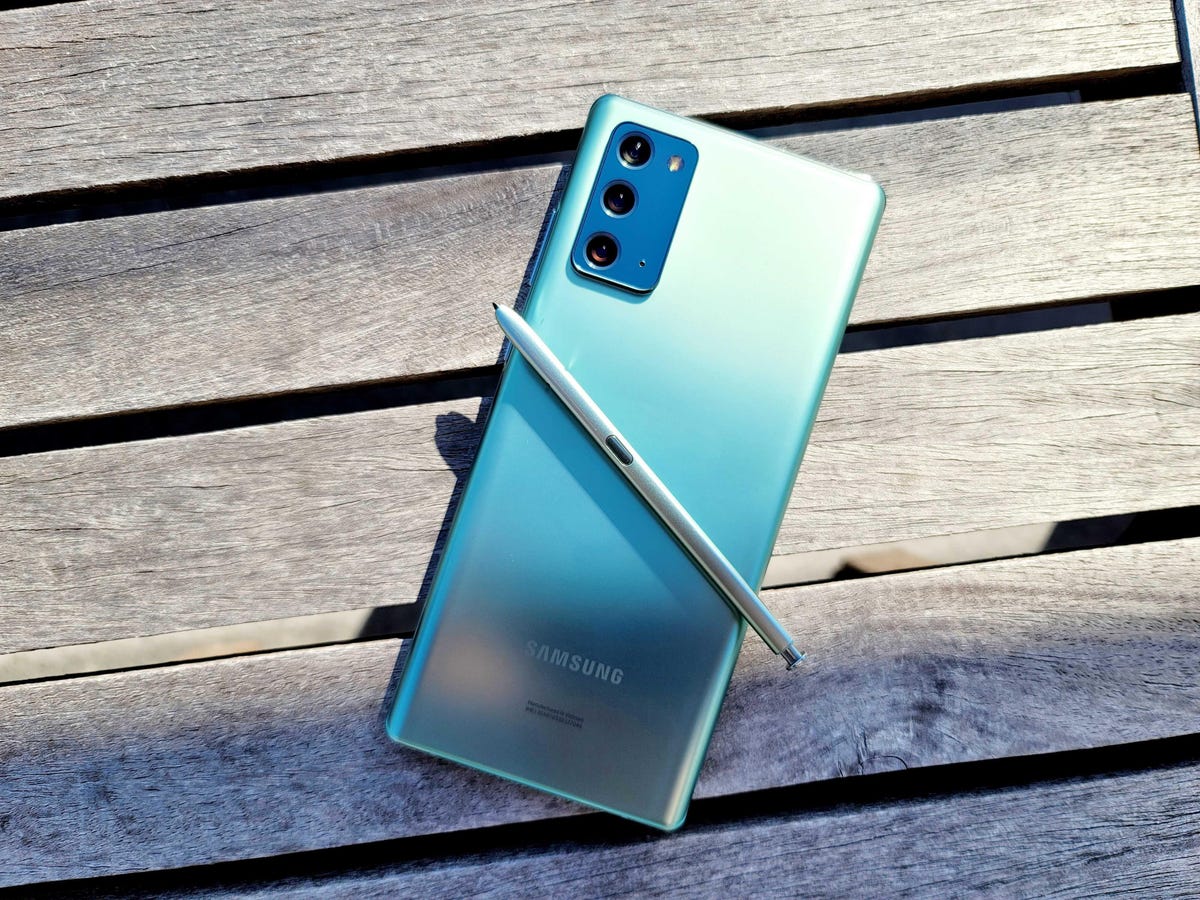
Samsung's Galaxy Note 20 in mystic green.
Jessica Dolcourt
There's no twisted screen on the Note 20 the way there is on the Ultra. That doesn't bother me, but the edge-to-edge display on both phones operating there are still plenty of accidental screen presses when you're naively holding the phone. For example, if you're passively watching a video and progresses your finger to find a more comfortable grip, you may wind up inadvertently triggering a button.
The remaining design difference worth noting is the 120Hz screen refresh rate on Ultra, compared to the standard 60Hz rate on the Note 20. It won't make a difference if you're switching from a 60Hz visited, but it can feel comparatively "slow" if you're switching from a visited with a 90Hz or 120Hz display.

The Galaxy Note 20, left, has a plastic back, compared to the Note 20 Ultra, right, which has a glass back.
John Kim
The Note 20 Ultra is the positive camera winner
The Ultra's has a massive and protruding camera array on its back to accommodate larger sensors and perhaps help it unfriendly out. Meanwhile, the Note 20's camera bump makes the visited less top-heavy and prone to rocking when you write on it at what time it's on a flat surface.
But the Note 20 Ultra took better photos overall. You're going to get great great shots no company which phone you use, when you're taking photos in brightly lit conditions: saturated colorful, crisp edges, the works. But if you're at all enthusiastic in zoom photography, the Ultra's 5x optical zoom takes the crown. Not only does it get you very good telephoto images up to 5x, it can also go up to 50x.

This cute harbor seal was photographed at 30x on the improper Note 20.
Jessica Dolcourt

Same seal, shot on Galaxy Note 20 Ultra at 50x zoom.
Jessica Dolcourt
The Note 20's 3x optical to 30x AI-assisted zoom is mild good as well, and better than the Galaxy Z Fold 2 (which has 2x optical zoom), but image quality at 30x was better on the Ultra than on the unfamiliar Note 20. Most of the time the Note 20 will fulfill your photographic organizes. But when I took them both to the moody Northern California flit, many of my nature shots were simply better on the Ultra and I worn-out reaching for the note 20 altogether.
The Ultra has a 108-megapixel camera you can use to crop into shots for more detail, a feature I've found to have uneven results.
Camera: Note 20 vs. Note 20 Ultra
Galaxy Note 20 | Galaxy Note 20 Ultra | |
Main camera | 12-megapixel (f1.8, Dual Pixel AF, OIS, 1.8μm, 79-degree FOV, 1/1.76-inch image sensor) | 108-megapixel (f1.8, OIS, 0.8μm, 79-degree FOV, 1/1.33-inch image sensor) |
Ultra-wide angle | 12-megapixel (f2.2, 1.4μm, 120-degree FOV) | 12-megapixel (f2.2, 1.4μm, 120-degree FOV) |
Telephoto | 64-megapixel (f2.0, 0.8μm, 76-degree FOV) | 12-megapixel (f3.0, 1.0μm, 20-degree FOV) |
Front-facing camera | 10-megapixel (f2.2, 1.22μm, 80-degree FOV) | 10-megapixel (f2.2, 1.22μm, 80-degree FOV) |
Zoom | 3x hybrid | 5x optical |
Super Zoom | 30x | 50x |
Laser auto-focus sensor | No | Yes |
Video capture | 8K | 8K |
Features the Note 20 and Ultra share
- 5G data speeds (some sections have 4G models)
- Signature Note S Pen stylus
- Android 10 out of the box
- Snapdragon 865+ processor (other markets use a Samsung Exynos chip)
- Extras like fast wireless charging
Other indispensable differences
- Screen size, battery (4,300 vs. 4,500)
- MicroSD card
- 512GB option with Ultra
- 8GB RAM versus 12GB RAM on Ultra
Should you buy the Note 20, Note 20 Ultra, or a different phone?
The Note 20 Ultra is too big, too heavy and too expensive. But I'd still personally buy it over the Note 20 because I do find myself amdroll the extra camera features. However, I don't actually think it's pleasant $300 more than the Note 20 just to have a 120Hz cover, 5x optical zoom instead of 3x, a glass funding and a microSD card storage option -- plus all the novel extras.
Most people will be happier with the cheaper Note 20 over the Ultra, but again, I think Samsung has overcharged for both phones at their full retail effect, and I find the Note 20's $1,000 price tag for what is essentially a plastic shouted cheeky at best and insulting at worst.
For either shouted, look for a deal. I'd be happier to pay $1,000 for the Ultra and $700 for the improper Note 20, if we're keeping Samsung's $300 price delta intact.
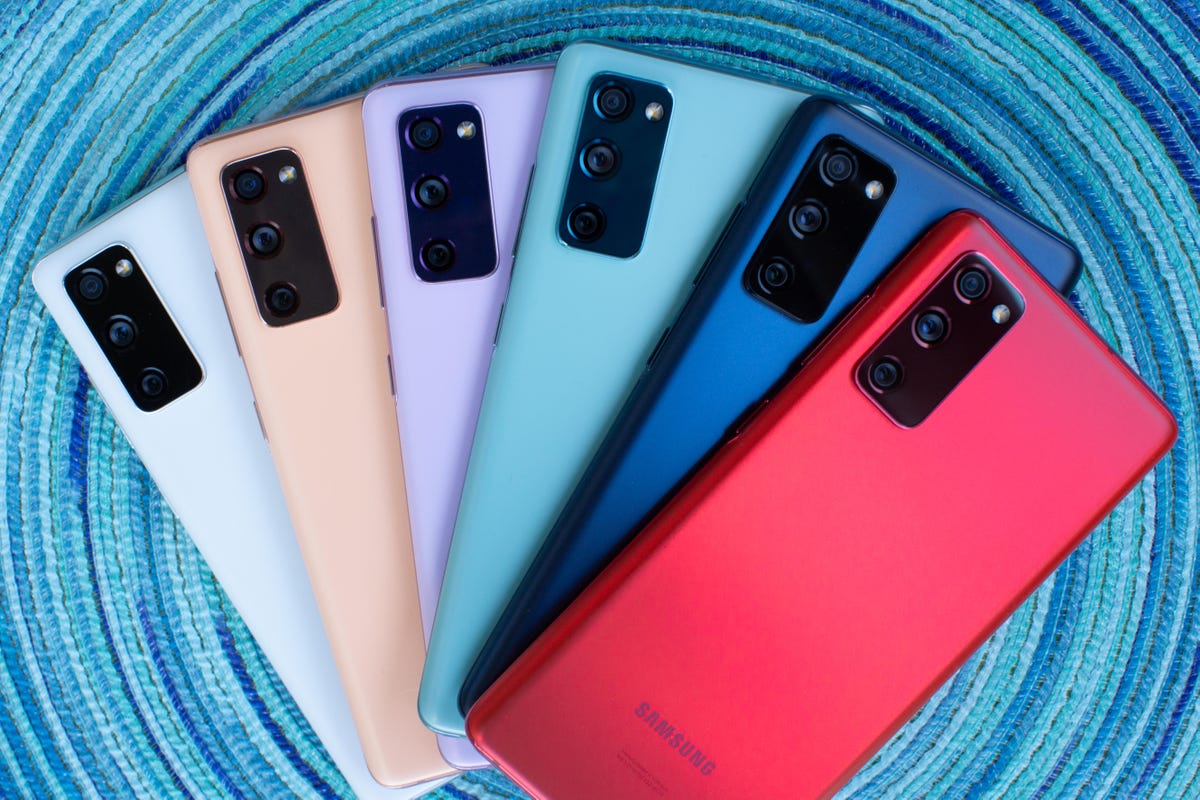
The Galaxy S20 FE comes in a map of colors.
Angela Lang
Here's novel alternative within the Samsung cosmos. The newer Galaxy S20 FE (Fan Edition) is a middle way. It merges some of the Ultra's best features with the Note 20's cost-cutting trade-offs, bringing you a 6.5-inch display with a fast 120Hz refresh rate, a big 4,500-mAh battery, 3x optical zoom and a rear plastic backing. There's expandable storage, too, and of course, support for 5G data speeds.
While the cameras won't be quite as good, and there's no S Pen stylus, the Galaxy S20 FE is the best buy in conditions of value, if not a status symbol -- conception it does come in fun colors.
Best yet, it starts at $700 full retail and was already on sale for $600 in some stores by the time it hit the market. With trade-in values and seasonal deals, I expect that effect to fall.
Galaxy Note 20 vs Note 20 Ultra vs S20 FE
Samsung Galaxy Note 20 | Samsung Galaxy Note 20 Ultra | Samsung Galaxy S20 FE | |
Display size, resolution | 6.7-inch; 2,400x1,080 pixels | 6.9-inch; 3,088x1,440 pixels | 6.5-inch ample AMOLED; 2,400x1,080 pixels |
Pixel density | 393ppi | 496ppi | 405ppi |
Dimensions (Inches) | 6.36 x 2.96 x 0.33 in | 6.49 x 3.04 x 0.31 in | 6.29 x 2.97 x 0.33 inches |
Dimensions (Millimeters) | 161.6 x 75.2 x 8.3 mm | 164.8 x 77.2 x 8.1mm | 159.8 x 75.5 x 8.4mm |
Weight (Ounces, Grams) | 6.84 oz, 194g | 7.33 oz, 208g | 190g |
Mobile software | Android 10 | Android 10 | Android 10 |
Camera | 12-megapixel (ultra-wide), 12-megapixel (wide-angle), 64-megapixel (telephoto) | 12-megapixel (ultra-wide), 108-megapixel (wide-angle), 12-megapixel (telephoto) | 12-megapixel (standard), 12-megapixel (ultra-wide), 8-megapixel (3x telephoto) |
Front-facing camera | 10-megapixel | 10-megapixel | 32-megapixel |
Video capture | 8K | 8K | 4K |
Processor | Snapdragon 865+ | Snapdragon 865+ | Qualcomm Snapdragon 865 (5G) Samsung Exynos 990 (4G) |
Storage | 128GB | 128GB, 512GB | 128GB |
RAM | 8GB | 12GB | 6GB |
Expandable storage | No | Up to 1TB | 1TB |
Battery | 4,300mAh | 4,500mAh | 4,500mAh |
Fingerprint sensor | In-screen | In-screen | In-screen |
Connector | USB-C | USB-C | USB-C |
Headphone jack | No | No | No |
Special features | S Pen stylus; 5G connectivity; Wireless PowerShare; soak resistant (IP68) | 120Hz screen refresh rate, 5x optical zoom, UWB sharing, S Pen stylus; 5G connectivity; Wireless PowerShare; water resistant (IP68) | 120Hz camouflage refresh rate, support for 30W fast charging and 15W fast wireless charging |
Price off-contract (USD) | $1,000 | $1,300 (128GB), $1,450 (512GB) | $699 |
Price (GBP) | £849 (4G), £949 (5G) | £1,179 | £599 (4G), £699 (5G) |
Price (AUD) | AU$1,499 (4G), AU$1,649 (5G) | AU$1,849 (4G), $AU$1,999 (5G) | AU$999 (4G), AU$1,149 (5G) |
First emanated Oct. 10
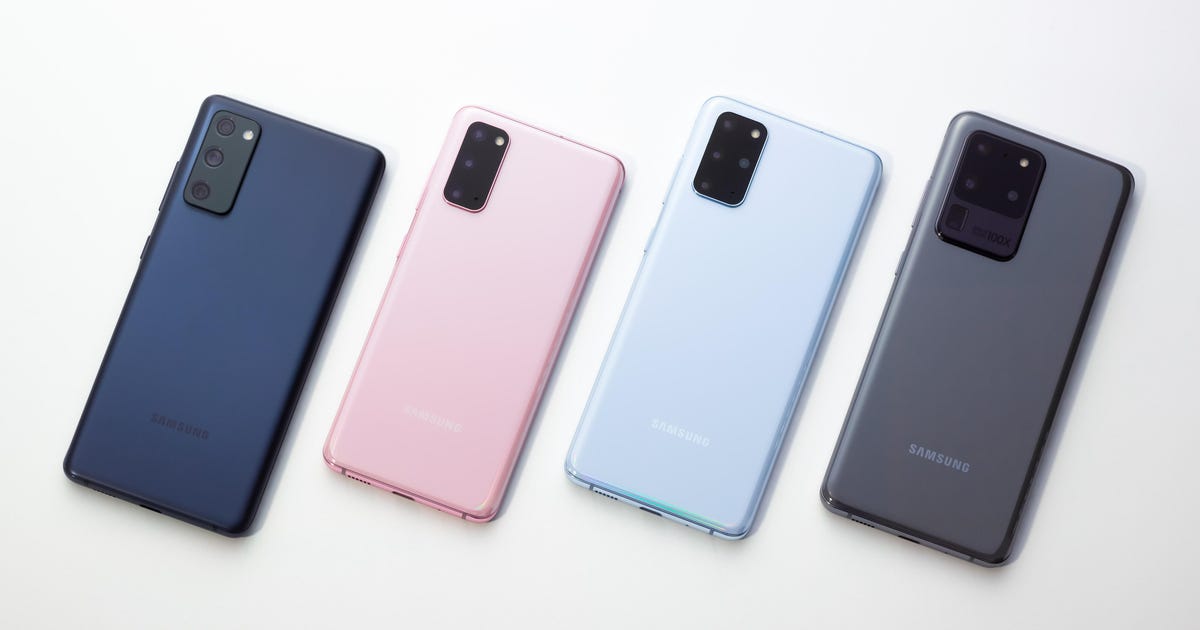
Galaxy S20 FE vs. latest S20 phones: Here's why the Fan Edition is so much cheaper
Back in September, Samsung added a new member to its premium Galaxy S20 family in the form of the Galaxy S20 Fan Edition. The device costs $700 (£599, AU$999), handily stealing the crown from the $1,000 (at launch) Galaxy S20 and decision-exclusive it the most affordable phone in Samsung's premium S20 line. That raises an determined question: What compromises were made to drive down the cost, and therefore the starting imprint, of the S20 FE?
On paper at least, there don't seem to be many core differences between the phones. The 6.5-inch S20 FE retains many of the top-shelf features untrue in its flashier siblings. Along with a sharp AMOLED indicate coupled with ultra-fast refresh rates, it has a tall battery, an IP68 rating (for water and dust resistance) and multiple cameras on its rear, comprising a telephoto lens.
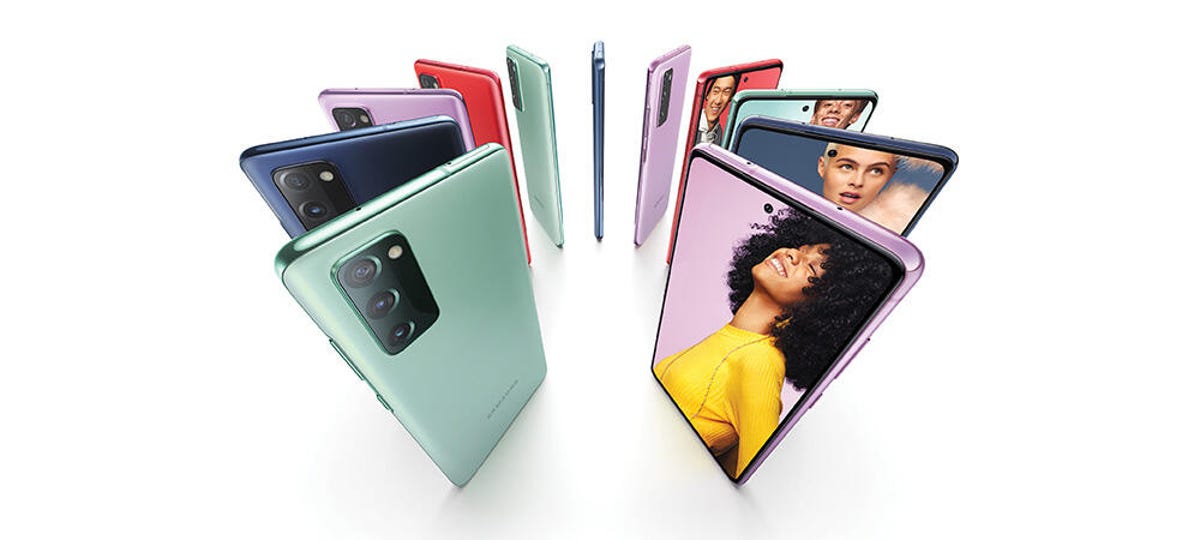
Samsung's Galaxy S20 FE line comes in six colors.
Samsung
Where Samsung does make compromises is in its harvest of material. The S20 FE, unlike its fancier siblings, has a back made of plastic instead of glass. It has less RAM and storage than its family members, and there are some concessions on its rear camera setup, but you might not even miss them. 8K video recording and 100x Space Zoom are absent, but 30x zoom is available (like what's featured in the S20 and S20 Plus) and so is 3x optical zoom.
To learn more approximately the differences and similarities of Samsung's S20 line, take a look at our specs chart below.
Galaxy S20 Fan Edition vs. latest Galaxy S20 phones
Samsung Galaxy S20 FE | Samsung Galaxy S20 | Samsung Galaxy S20 Plus | Samsung Galaxy S20 Ultra | |
|---|---|---|---|---|
Display size, resolution | 6.5-inch trustworthy AMOLED; 2,400x1,080 pixels | 6.2-inch Dynamic AMOLED 2X; (3,200 x 1440) | 6.7-inch Dynamic AMOLED 2X | 6.9-inch Dynamic AMOLED 2X |
Pixel density | 405ppi | 563ppi | 525ppi | 511ppi |
Dimensions (Inches) | 6.29x2.97x0.33 inches | 2.72x5.97x0.311 inches | 2.9x6.37x0.30 inches | 2.99x6.57x0.35 inches |
Dimensions (Millimeters) | 159.8x75.5x8.4mm | 69.1x151.7x7.9 mm | 73.7x161.9x7.8mm | 76.0x166.9x8.8mm |
Weight (Ounces, Grams) | 6.7 oz; 190g | 5.75 oz; 163g | 6.56 oz; 186g | 7.76 oz; 220g |
Mobile software (at launch) | Android 10 | Android 10 | Android 10 | Android 10 |
Camera | 12-megapixel (standard), 12-megapixel (ultra-wide), 8-megapixel (3x telephoto) | 12-megapixel (wide-angle), 64-megapixel (telephoto), 12-megapixel (ultra-wide) | 12-megapixel (wide-angle), 64-megapixel (telephoto), 12-megapixel (ultra-wide), time-of-flight camera | 108-megapixel (wide-angle), 48-megapixel (telephoto), 12-megapixel (ultra-wide), time-of-flight camera |
Front-facing camera | 32-megapixel | 10-megapixel | 10-megapixel | 40-megapixel |
Video capture | 4K | 8K | 8K | 8K |
Processor | Qualcomm Snapdragon 865 (5G) Samsung Exynos 990 (4G) | 64-bit octa-core processor (Max 2.7GHz + 2.5 GHz + 2.0 GHz) | 64-bit octa-core processor (Max 2.7GHz + 2.5 GHz + 2.0 GHz) | 64-bit octa-core processor (Max 2.7GHz + 2.5 GHz + 2.0 GHz) |
Storage | 128GB | 128GB | 128GB, 512GB | 128GB, 512GB |
RAM | 6GB | 12GB (5G), 8GB (LTE) | 12GB (5G), 8GB (LTE) | 12GB, 16GB |
Expandable storage | 1TB | Up to 1TB | Up to 1TB | Up to 1TB |
Battery | 4,500 mAh | 4,000 mAh | 4,500 mAh | 5,000 mAh |
Fingerprint sensor | In-screen | In-screen | In-screen | In-screen |
Connector | USB-C | USB-C | USB-C | USB-C |
Headphone jack | No | No | No | No |
Special features | 5G enabled, IP 68 rating, 120Hz screen refresh rate, support for 30W fast charging,15W fast wireless charging | 5G enabled; 120Hz refresh rate; stream resistant (IP68) | 5G enabled; 120Hz refresh rate; stream resistant (IP68) | 5G enabled; 120Hz refresh rate; 100X zoom; stream resistant (IP68) |
Price off-contract (USD) *at launch | $700 for sub-6 5G; $750 for Verizon model with mmWave 5G | $999 | $1199, $1,349 | $1,399 (128GB), $1,599 (512GB) |
Price (GBP) | £599 (4G), £699 (5G) | £799, £899 (5G) | £999 (5G) | £1,199 (128GB), £1,399 (512GB) |
Price (AUD) | AU$849 (4G), AU$999 (5G) | AU$1,349 (4G), AU$1,499 (5G), | AU$1,499 (4G), AU$1,649 (128GB), AU$1,899 (512GB) | AU$1,999 (128GB), AU$2,249 (512GB) |
Blog Archive
-
▼
2022
(99)
-
▼
July
(15)
- Samsung's next update will make your Galaxy phone ...
- Best Samsung Galaxy A53 5G Case for 2022
- Samsung Galaxy Z Fold 3 durability: Did the phone ...
- The Galaxy S21 lineup is here, with a $200 price c...
- Samsung Galaxy S II (U.S. Cellular) review: Samsun...
- Galaxy Note 20: Here's who should buy it and who s...
- Galaxy S20 FE vs. other S20 phones: Here's why the...
- Samsung confirms no new Note at Unpacked, but will...
- Samsung Galaxy Z Fold 4 Design and Camera Details ...
- Xbox Games Arrive On Samsung TVs in Cloud Gaming Push
- Galaxy S21 vs. Pixel 5: Which Android phone should...
- Pixel 6 Pro vs. iPhone 13 Pro vs. Samsung S21 Ultr...
- Galaxy S21: Samsung didn't bring back the headphon...
- Galaxy Note 10 vs. S10: Honestly, we don't think t...
- Galaxy S22 Plus Camera Testing: How It Compares to...
-
▼
July
(15)
